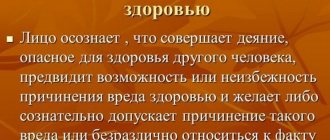Criminal Code of the Russian Federation in the latest edition:
Article 115 of the Criminal Code of the Russian Federation. Intentional infliction of minor bodily harm
1. Intentional infliction of slight harm to health, causing short-term health disorder or minor permanent loss of general ability to work, -
shall be punishable by a fine in the amount of up to forty thousand rubles, or in the amount of the wages or other income of the convicted person for a period of up to three months, or by compulsory labor for a term of up to four hundred eighty hours, or by corrective labor for a term of up to one year, or by arrest for a term of up to four months.
2. The same act committed:
a) for hooligan reasons;
b) for reasons of political, ideological, racial, national or religious hatred or enmity, or for reasons of hatred or enmity towards any social group;
c) using weapons or objects used as weapons;
d) in relation to a person or his relatives in connection with the performance of official activities by this person or the performance of public duty, -
shall be punishable by compulsory labor for a term of up to three hundred sixty hours, or correctional labor for a term of up to one year, or restriction of liberty for a term of up to two years, or forced labor for a term of up to two years, or arrest for a term of up to six months, or imprisonment for a term of up to two years.
Return to the table of contents of the document: Criminal Code of the Russian Federation in the latest edition
Comments on Article 115 of the Criminal Code of the Russian Federation
The object of the crime is human health.
The objective side is characterized by an act (action or inaction) in the form of causing minor harm to health, causing a short-term health disorder or a minor permanent loss of general ability to work.
The methods of committing this crime do not differ from other types of harm to health.
The corpus delicti is material: the crime is completed when negative consequences occur in the form of causing minor harm to health.
The content of signs of minor harm to health is disclosed in the Medical criteria for determining the severity of harm caused to human health, namely:
- temporary dysfunction of organs and (or) systems (temporary disability) lasting up to three weeks from the moment of injury (up to 21 days inclusive) (clause 8.1);
- minor persistent loss of general ability to work - persistent loss of general ability to work less than 10 percent (clause 8.2).
Current legislation thus excludes a lower threshold for the duration of temporary disability. Therefore, under Art. 115 of the Criminal Code of the Russian Federation should include temporary disability of any duration within 21 days.
Practice recognizes as minor harm to health: weakened vision or hearing, loss of one finger on the hand (except for the index and thumb), impaired grasping ability of the left wrist, etc.
According to the table of percentages of Medical criteria for permanent loss of general ability to work as a result of various injuries, poisonings and other consequences of external causes, examples of minor harm to health are: mild concussion; decrease in visual acuity of each eye as a result of direct trauma to 0.4; purulent inflammation of the middle ear (one or both ears); impaired nasal breathing as a result of injury (unilateral or bilateral); moderate malocclusion and chewing due to a fracture of the zygomatic bone, upper or lower jaw; loss of 2 to 6 permanent teeth, etc.
Causing harm to health that had immediate consequences, was accompanied by health problems for less than six days and did not lead to minor loss of ability to work (for example, multiple abrasions, bruises, small superficial wounds) may be classified depending on the circumstances under Art. Art. 116, 117 of the Criminal Code of the Russian Federation.
Minor harm to health may be an element of the objective side of another crime (for example, robbery, rape, etc.), in this case it does not receive an independent legal assessment. Likewise, the infliction of minor harm does not require independent qualification if, along with it, in the process of using violence, the victim was inflicted with harm of a different degree of severity.
The subjective side of the crime is characterized by guilt in the form of direct or indirect intent. A person is aware of the public danger of causing minor harm to health, foresees the possibility or inevitability of the consequences and desires (with direct intent) or consciously admits the fact of causing minor harm to health or is indifferent to it (with indirect intent). The motives and purposes of the crime (except for those specified in Part 2 of Article 115 of the Criminal Code of the Russian Federation) do not affect the qualifications of the crime.
When qualifying an act, the content and direction of the intent of the perpetrator must be accurately established. If the perpetrator had the intention to cause more serious harm to health or death to the victim, but the desired consequences did not occur due to circumstances beyond his control and the victim was actually caused minor harm to health, the act is qualified in accordance with the direction of intent as an attempt to commit a more serious crime.
Careless infliction of minor bodily harm does not entail criminal liability.
subject of the crime is a physically sane person who has reached the age of sixteen.
In the second part of Art. 115 of the Criminal Code of the Russian Federation concentrates the qualifying signs of causing minor harm to human health:
- a) for hooligan reasons;
- b) for reasons of political, ideological, racial, national or religious hatred or enmity, or for reasons of hatred or enmity towards any social group;
- c) using weapons or objects used as weapons.
The qualifying signs of intentional infliction of minor harm to health (Part 2 of Article 115 of the Criminal Code of the Russian Federation) are similar to the considered corresponding signs of intentional infliction of serious harm to health (Article 111 of the Criminal Code of the Russian Federation).
What laws govern it?
According to the legislation of the Russian Federation, the severity of threats depends on various aspects, therefore the criminals themselves must be punished in accordance with the significance of the crimes they committed. The following things must be taken into account (Article 119):
- Reasons why one citizen threatens another.
- Motive (why the person making the threat wants to harm the other).
A person who violates Article 119 of the Criminal Code of the Russian Federation often actually carries out his threats. In this case, he may also violate the law under the following articles:
- Article 105 (murder). Duration: not less than six, but not more than fifteen years.
- Article 111 (serious harm to health). Strictly up to eight years in prison.
- Art. 112 (moderate severity). Arrest for no more than six months or up to three years of compulsory labor.
- Art. 115 (mild severity). Correctional labor or a fine of up to 40,000 rubles.
- Article 116 (beatings). Up to a year of work or no more than two years of imprisonment.
- Article 117 (torture). Maximum 3 years of forced labor or restriction of freedom for the same period of time.
Read more about the classification of health severity degrees in this article.
It is obvious that for violation of each of these articles a much more severe punishment is provided than for Article 119 of the Criminal Code of the Russian Federation. The victim of threats must be aware that each of the above crimes can be committed by threats against him.
Recommended publications:
- Causing minor harm to health (short-term health disorder of the victim or minor permanent loss of general ability to work)
- Batterings and minor harm to health. Differences in punishment and consequences (table with sanctions for acts provided for in Articles 116, 116.1 and 115 of the Criminal Code of the Russian Federation)
- Compensation for moral damage for beatings and harm to health (how to adequately assess the amount of moral damage caused to me by beatings? Is there such a method for determining my suffering?)
- Amount of compensation for moral damages for minor injuries to health. Judicial practice (examples from judicial practice of consideration of cases on the recovery of compensation for moral damage for causing minor harm to health)
- Amount of compensation for moral damages for beatings. Judicial practice (the right of a citizen to compensation for harm caused to life or health is one of the generally recognized fundamental inalienable human rights and freedoms)
- Statement of claim for compensation for moral damage caused by a crime (beatings or harm to health of varying degrees of severity);
- Statement of claim for compensation for moral damage caused by a crime (beatings, harm to health). Request for compensation in equal shares to the two defendants - the tortfeasors.
- Where to go if you were assaulted? (citizens report allegations of beatings to both magistrates, law enforcement agencies, and the prosecutor’s office).
- Statement of assault to the police. Sample (injury was caused by an acquaintance)
- We recommend other publications in the review “Beatings and harm to health. Responsibility. Arbitrage practice"
Possible forms
The severity of the threat does not depend on the form in which it is carried out. The possibility of committing illegal actions, in this regard, means much more, since it can bring not only moral, but also real physical harm.
The forms of threat are quite diverse, in addition, each individual violator of Article 119 can come up with a new one or use several at once.
For these reasons, there is no specific registry of threat forms. But you can easily understand which ones are used more often than others. The most well-known forms of threats are as follows:
- Oral (in words).
- Written (written on paper).
- Gestures (there is one very common one: the threatening one moves his hand across his neck).
- In electronic form (message by E-mail or on a social network, for example).
What responsibilities are provided?
For violation of Part 1 of Article 119 of the Criminal Code of the Russian Federation, a more lenient punishment is provided than for violation of Part 2 of Article 119 of the Criminal Code of the Russian Federation. More precisely, there are several punishment options for the violator:
- Mandatory work (up to 480 hours).
- No more than two years of imprisonment.
- Arrest for no more than six months.
For violation of part 2 of Article 119, you will have to suffer the following types of punishment:
- Maximum 5 years of correctional labor and a ban on working in certain professions.
- Imprisonment for up to five years and, similarly, a ban on holding certain positions for three years.
We discussed the issue of threats in more detail in the section – Threats under the Criminal Code of the Russian Federation.
Qualifying features
Qualifying features are mentioned in Article 119, paragraph 2 of the Criminal Code of the Russian Federation , the court counts them as an aggravating circumstance. Without them, the punishment is indeed much milder. Based on such signs, the investigation will be able to quickly determine the most likely motives for committing a crime. Why do some signs worsen the situation of the threat so much?
The point here is that the crime still remains the same, but in addition to them, additional, special motives arise for its commission. Some of these motives can even be equated to extremism. For these reasons, a more severe punishment is provided if, according to Article 119:
- The crime was committed on religious grounds.
- The crime was committed for political reasons.
- Crime due to ethnic hatred, racism.
- The crime is based on discrimination on any grounds (social, gender or other).
Citizens who commit a crime under Part 2 of Article 119 rightly receive a harsher punishment, since their motives are not personal; rather, they are even inherent in special criminal groups.
Discrimination from violations of other articles
There are certain special elements of crime, and violation of a specific article 119 must be separated from violation of other articles of the Criminal Code of the Russian Federation, namely:
- Article 296 – threats against justice.
- Article 309 – threats against a prosecution witness in order to force him to say what is more beneficial to the offender.
- Article 318 – violence against representatives of justice/authority.
- Article 321 – threats or implementation of physical violence by a convicted person against the authorities.
- Article 333 – resistance to superiors in military service.
They all have a similar focus, but they have completely different goals. There should not be an equal sign between them.





